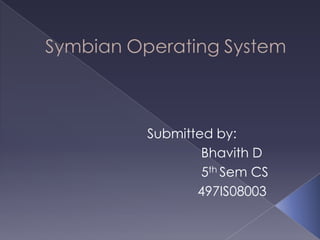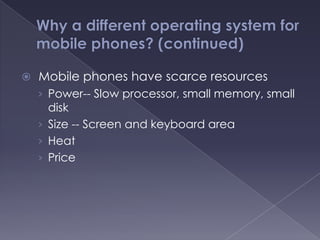Symbionic os
- 1. Submitted by:Bhavith D 5th Sem CS 497IS08003
- 2. IndexIntroduction. Why a different operating system for mobiles? Different operating system vendors Defining Symbian Architecture Core Strength of Symbian OS Why is it an open operating system? Malware Conclusion
- 3. Why a different operating system for mobile phones? (continued)Mobile phones have scarce resourcesPower-- Slow processor, small memory, small disk Size -- Screen and keyboard areaHeat Price
- 4. Different vendors of operating systems.Symbian Mobile (Microsoft)PalmLinuxBlackberry (Developed by research in motion)
- 5. Defining SymbianSymbian OS is an operating system, designed for mobile devices, with associated libraries, user interface frameworks and reference implementations of common tools, produced by Symbian Ltd,and runs on ARM processors. Symbian OS, is structured like many desktop operating systems with pre-emptive multitasking and memory protection.
- 6. ArchitectureSymbian OS has the following componentsCoreSystem Layer Application EnginesUser interface SoftwareApplication
- 7. Architecture (contd)Symbian OS core is common to all devices, i.e. kernel, file server, memory management and device drivers. Above this core, components can be added or removed depending on the product requirements.Symbian is developed using object oriented design
- 8. Core Strength of Symbian OSEvent ManagementSymbian is designed to have event based time sharing in a single threadAn event-based implementation results in better performance, and simpler, more manageable, and portable code. Power managementSymbian OS and is designed to make efficient use of the processor and peripherals and so minimize power usage. When peripherals are not being used they are switched off by the system
- 9. Core Strength of Symbian OSRobust and DependableDevices should not lose user data, crash or require rebooting. Each process runs in a protected address space
- 10. Core Strength of Symbian OSMemory ManagementMemory available on a Symbian OS device is often quite limited because of device sizeIt assumes that memory is limited and minimizes consumption at every turn. Full multitaskingSymbian OS runs each application as a separate process It allows multiple applications to run concurrently Uses active scheduler and active objects to achieve multitasking
- 11. Symbian an open operating system?Open to anyone to licenseOpen to anyone to develop applicationsBased on open standardsOwned by the industry
- 12. Malware (Malicious Software)There are a lot of software, viruses and worms that affect the symbian OS. Bluetooth using worm, affects series 60 phonesReplicates over Bluetooth and arrives phones as caribe.sisWhen installed it starts looking for new devices over Bluetooth
- 13. Malware (Malicious Software)Flerprox(25th Sep 2006)Malicious SIS trojan that installs executable filesCauses the device to restart on installationIt creates a file that crashes fexplorer
- 14. Malware (Malicious Software)DoombootDrops corrupted system binaries into the infected deviceCause the device to fail at next rebootDoomboot.A pretends to be cracked version of Symbian version of Doom 2.
- 15. Ways to prevent MalwareNever keep Bluetooth on when you are not using it.
- 16. Never receive Bluetooth messages from unknown phones
- 17. Check for installation signature checks when installing software ConclusionVery flexible Allows manufacturers to tailor their products to their specifications Various types of devices for different market segmentsOn November 16, 2006, the 100 millionth smartphone running Symbian OS was shipped.This is not the end, its just a beginning .
- 18. THANK YOU
















